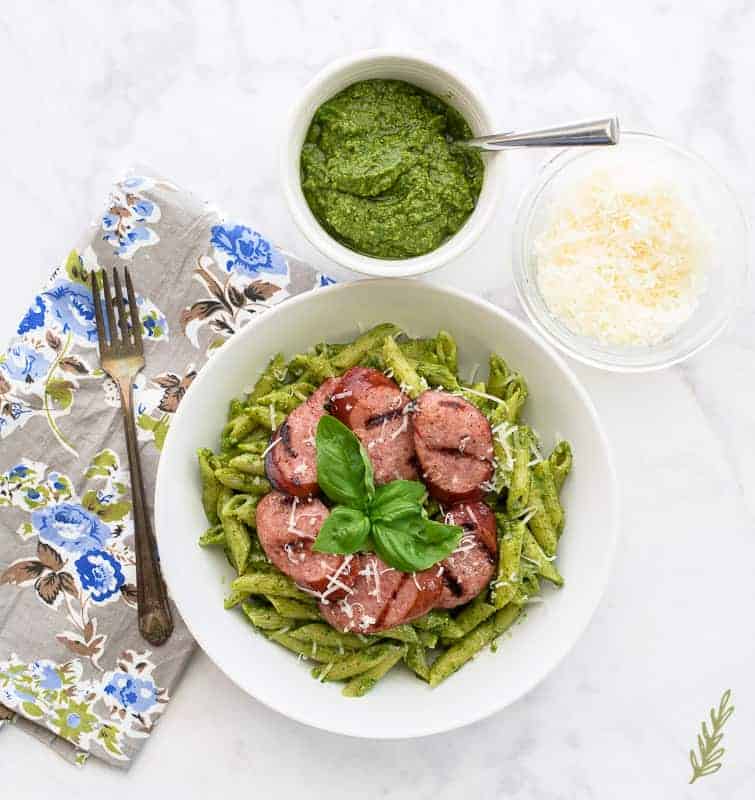 My basil plant has mutated. I know for a fact that I only planted one basil plant. So someone tell me why I now have five plants in my garden bed! Now, I’m a creative chef, so I can figure out a recipe for damn near anything, but this is a lot of pressure. The most noteworthy way to use basil is in the classic Ligurian recipe- pesto. But, since I’m not a slacker, it can’t be just any old boring pesto. “Marta-fied” pesto to stage, please!
My basil plant has mutated. I know for a fact that I only planted one basil plant. So someone tell me why I now have five plants in my garden bed! Now, I’m a creative chef, so I can figure out a recipe for damn near anything, but this is a lot of pressure. The most noteworthy way to use basil is in the classic Ligurian recipe- pesto. But, since I’m not a slacker, it can’t be just any old boring pesto. “Marta-fied” pesto to stage, please!

Unfortunately- or maybe fortunately (I haven’t quite decided)- the basil took this to mean it could run amok in the yard…and run amok, it did. It’s healthy, vibrant and thriving…and it’s encroaching on the mint and blueberry bush. I’m afraid if I don’t harvest and use it, I’m going to create a new mintbasilberry hybrid. That could either lead me to the Nobel Prize, or to the Monsato hit list. I’d prefer the former.

Traditional pesto is made with pine nuts, garlic, olive oil, parmesan (or pecorino) cheese, and basil. This version swaps out the pine nuts for pistachios, and the parm for asiago (another hard Italian cheese). Like me, you can play around with the ingredients you use.
Instead of pistachios try:
- walnuts
- almonds
- macadamia nuts
Replace the asiago with:
- romano
- comte
- aged gouda
The right basil is essential to a great pesto. Obviously, the preferred basil to use would be the Genovese variety, but the common “Classico” is a another favorite for this recipe. Avoid the use of Thai or Purple basils, as they have very different flavor profiles.
An important step in creating a smooth- not bitter- pesto, is to remove the stems of the basil leaves. These guys may be small and thin, but they contribute nothing good to the sauce. It only takes a minute to do, but the end result is so worth it.
Pick off the stems of the basil and wash the leaves throughly. Set them onto a few layers of paper, or kitchen, towels to dry them while you prep the remaining ingredients.
I LOVEEEEEEE pistachios.
Roasted, salted pistachios are my kryptonite and the only thing that stops me from becoming addicted is how expensive they can be. Although pistachios are a bit costly, they’re no where near as expensive as pine nuts. That’s the reason why I hardly ever make my pesto the traditional way. Not only that, but I don’t think they taste that good. Hence, my penchant for ‘stachios.
In order to extract as much flavor as possible from the little seeds, you need to toast them for a few minutes in moderate heat. Just set the pistachios on a small sheet pan to do this. While I’m at it, I throw on the garlic I’m going to use in my pesto to toast as well. Once you’ve tasted garlic that been even slightly warmed, you’ll never do it any other way. However, toasting the garlic is optional. Toasting the pistachios needs to happen. Toast them in a 300°F oven for 5 minutes or until you can smell their fragrance wafting through the air.
Once your seeds are toasty, pull the pan from the oven and let things cool down for a minute or two. Then toss everything on the pan into a blender.
Add the picked basil leaves and the lemon juice. I love the addition of lemon juice to pesto because it makes something that’s already vibrant in flavor, even brighter. It’s like shining a light in your eyes…only the light’s in your mouth…does that make sense? It does to me. Moving on…
Blend the herb, seeds, garlic, and lemon juice together until the basil leaves start to break up a bit.
I hate my blender.
Sure, it’s close to ten years old, but that doesn’t give it the excuse to act like it doesn’t want to work on me, amiright?! Anywho, this thing gives me more problems than it’s worth, so I have to coddle it every once in awhile. If your blender is being a jerk too, just pulse the mixture to get it moving. Sometimes adding a few hits of the olive oil with get things moving. I’m petitioning for a new blender for upcoming birthday…wish me luck. If you also hate your blender and have a food processor, you can use that instead.
Once the basil starts to break up, remove the plug from your blender’s lid and start drizzling in the olive oil. PLEASE use a high-quality olive oil! You may, or may not cook this pesto, so what you use is what you’ll taste. Those rancid, cheapo blends are not the way you want to go in this dish. Colavita is the brand I prefer. Drizzle the olive in and continue blending until you have a smooth paste.
The last ingredient to be added, besides salt, is the finely grated, freshly grated, asiago cheese. Asiago is a pungent cow’s milk cheese from the Veneto region of Italy. It comes from the region that neighbors Emilia-Romagna, where parmesan is produced, so I feel like I can pass without starting an international incident. Not all grated cheeses are equal as many of them are treated with an agent to prevent clumping. While we’re not melting the asiago in this recipe, we also don’t need any added filler to be introduced to the sauce. It takes two minutes, tops to grate your own piece of asiago, so I encourage you to do it.
Add the cheese to the blender and pulse a few times to incorporate it into the sauce. Season to taste with a pinch of salt and… you’re done!

You now have one of the most versatile sauces in the kitchen at your disposal. Since this makes enough pesto for use in two separate recipes, divide the pesto in half and freeze half. Fill a plastic freezer bag with the sauce, squeeze any excess air from the bag, then seal it. Lay the bag flat in the freezer and when it’s frozen solid, you can stand it up in the freezer. This not only saves space, it also makes it easy to break off the pesto in chunks if you want to use it just to flavor something. It also thaws much quicker if it’s in a thin sheet.
Use your pesto any number of ways: as a marinade for poultry or fish, a dipping sauce, to cover pizzas, or in this Penne in Pesto with Grilled Sausage Recipe. This pasta dish is a twenty minute meal that is a Godsend on those über-busy days we all have. Pin this sauce recipe for future reference and go blend up a batch for tonight’s dinner!

Asiago-Pistachio Pesto
at Sense & EdibilityIngredients
- 1/4 cup unsalted peeled pistachios
- 8 garlic cloves peeled
- 4 packed cups basil stems removed
- 1/4 cup freshly squeezed lemon juice
- 1 cup extra-virgin olive oil
- 1 cup freshly grated asiago cheese
- salt to taste
Instructions
- Preheat your oven to 300°F. Toast pistachios and garlic cloves on a small sheet pan for 5 minutes or until fragrant. Remove the pan from the oven and allow to cool for one minute.
- Add the seeds and garlic to the carafe of a blender or food processor, along with the basil and lemon juice. Blend everything together until the basil leaves start to break up a bit.
- Once the basil starts to break up, remove the plug from your blender's lid and start drizzling in the olive oil. Continue to blend the sauce until you have a smooth paste.
- Finally add the asiago cheese and pulse a few times to incorporate it into the sauce. Season to taste with a hearty pinch of salt and taste. Add more salt if desired.
Notes
**This post contains affiliate links. To find out what that means to you, please read my disclosure page**
Here are some more ways to use this pesto:
Chèvre & Prosciutto Flatbread topped with Figs and Arugula
DIY Meat and Cheese Board














